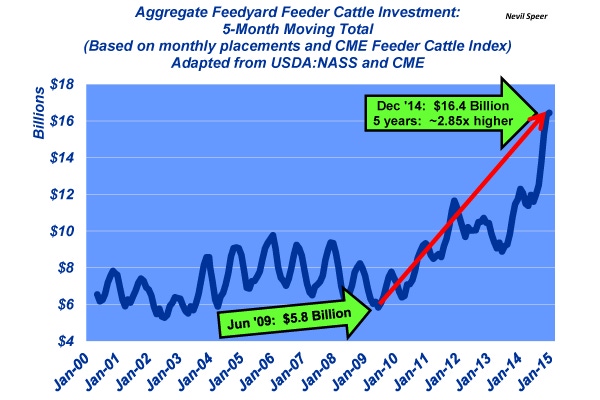Industry At A Glance: Feedyard investment spikes to an all-time high
From the bottom in 2009, the investment for a turn of feeder cattle, in aggregate, has grown by over $10 billion.
February 5, 2015

The surge in feeder cattle prices during the past several years has forced many stocker operators, traders and cattle feeders to expand their operating lines of credit. That said, the market’s recent retrenchment draws attention to the capital at risk within the beef industry.
Looking at the market is certainly important. However, applying the market to real-world investment provides a somewhat different perspective around the business. The accompanying graph highlights aggregate feeder cattle investment in feedyards over a 5-month period (roughly equal to a single turn of cattle – and thus the total reflects the aggregate capital required to generate a turn of cattle at any point in time).
The total is based on monthly placements, with an average placement weight of 750 pounds and the monthly average CME Feeder Cattle Index. Clearly, there’s some variation around the average weight of placements from month to month, but the most important aspect is the overall trend.
December’s total is approximately $16.5 billion – the highest mark in the historical series. Moreover, it’s three times larger than the total investment required just a little over 5½ years ago when feeder cattle bottomed out in summer 2009.

Given the market’s recent action and the cumulative investment at risk, how do you perceive cattle feeders’ financial position going into 2015? How have the higher capital requirements changed the business in recent years? And given that elevated investment, how might 2015 shape the industry if the market remains stubborn through the year?
Leave your thoughts in the comments section below.
You might also like:
100 biggest seedstock producers in the U.S.
6 things to consider as you clean out the vet cupboard
Prevention and treatment of cow prolapse
4 ways to raise better beef in 2015
Meet the biggest bull seller in the U.S.
9 ranch management concepts to improve your ranch
About the Author(s)
You May Also Like




.png?width=300&auto=webp&quality=80&disable=upscale)
